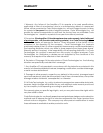
9
DESIGN PHILOSOPHY
I. Design Philosophy and Approach
The subtlety of the design process at this level of performance makes it impossible to
easily explain all of the advantages inherent in the Amplifier v10. However, we present
here an overview to give you an understanding of some of its unique features and an
idea of the listening experience you can expect. Often a particular technique has
numerous unrelated advantages and possibilities. We make every effort to exploit these
advantages with the final result being an amplifier that is greater than the sum of its
individual features
The topology and component selection is built on the foundation established by the
Amplifier System 100. Balanced interconnections are provided to take advantage of
their greater noise rejection as in the 100. Differential voltage gain throughout provides
exceptional rejection of external noise and contributes to the inherent DC stability of the
circuit. This allows direct coupling without servo circuitry. The unit also uses output
followers operating without feedback.
The front end of the Amplifier v10 is designed to operate without ever entering Class B
operation as is common in many other designs. This combined with excellent high
frequency design insures linear operation at high speed, and translates into a sonic
reproduction which is extremely transparent in character. The supply takes a very direct
approach to high performance. First, a top quality toroid transformer and over 100,000
uf of capacitance with very low ESR and inductance is used. For optimum performance
and reliability all circuity remains continuosly powered.
The specifications are consistent with what would be expected in a high current amplifier
design. In this design , however , an unusual degree of attention has been paid to
sonically meaningful parameters.
For example, the current stage is capable of producing peak currents in excess of 60
Amperes with a degree of linearity and speed which is not matched by other designs
when producing only a fraction of of this current. This is achieved by the implementation
of several distinct circuit features.
In the Amplifier v10 extremely wide bandwidth output transistors are used instead of the
usual TO3 devices which are used in other transistor designs. Each channel uses 8
individual output transistors with a combined power rating of 1600 Watts and 60 Amperes
with a bandwidth of 10 Mhz.
The manner in which the Amplifier v10 accomplishes Class A/AB operation is also
different than that employed in conventional designs. All Class AB designs leave Class
A operation when they are operated into loads of sufficiently low impedance or power
levels. Generally, this transition will produce a large and abrupt distortion increase.
The Amplifier v10 uses bias voltages and component values which have been specifi-
cally selected to produce a precision transition with no abrupt changes in distortion or
output impedance. This “Precision Bias” technique yields seemless performance regard-
less of the complexity of the load impedance and is particularly effective at eliminating
a form of IM distortion which often occurs in these instances.


















